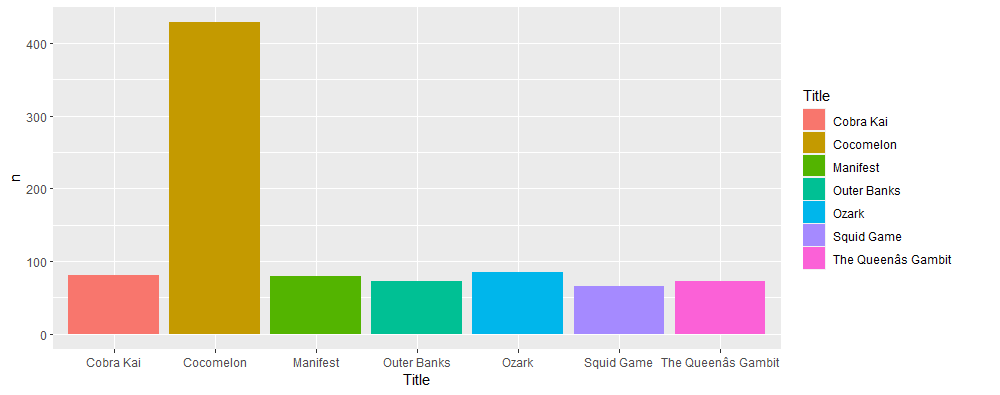Pandemic netflix consumption
During the pandemic 2020-2022 in the US
In this post I would like to look at some netflix data containing daily TOP10 on Netflix US during pandemic (04/2020-04/2022). Specifically, the dataset includes variables like Title (of the show/movie), the daily rank, the summed up count for being in the TOP10, the type (tv show/movie) and the viewership score.
The data source is https://www.the-numbers.com/netflix-top-10
Note: Use at your own risk. Be ethical about (user) data. This post will showcase how you can use simple statistics on everyday phenomena.
Required libraries
library(dplyr)
library(ggplot2)
library(stringr)
library(rstatix)
Looking at the data
After loading the data set, we look at the data (first 5 rows)
head(netflix_binge_data, 5)
## As.of Rank Year.to.Date.Rank Last.Week.Rank Title Type Netflix.Exclusive Netflix.Release.Date Days.In.Top.10 Viewership.Score
## 1 2020-04-01 1 1 1 Tiger King TV Show Yes Mar 20, 2020 9 90
## 2 2020-04-01 2 2 - Ozark TV Show Yes Jul 21, 2017 5 45
## 3 2020-04-01 3 3 2 All American TV Show Mar 28, 2019 9 76
## 4 2020-04-01 4 4 - Blood Father Movie Mar 26, 2020 5 30
## 5 2020-04-01 5 5 4 The Platform Movie Yes Mar 20, 2020 9 55
Some overall descriptives
Check if TV shows or movies dominated the TOP 10 in pandemic times.
netflix_binge_data %>% dplyr::count(Type, sort = TRUE)
## Type n
## 1 TV Show 4446
## 2 Movie 2611
## 3 Stand-Up Comedy 41
## 4 Concert/Perf… 2
TV shows do dominate the daily Top 10. Since this is time-series data, a show is counted multiple times. On day to day basis TV shows (n = 4446) are more frequently in the daily TOP 10 than Movie (n = 2611). This difference might be explained by the fact that watching a TV show with episodes takes longer or that the pandemic time increased binge watching habits.
Next we check what shows stayed in the TOP 10 the longest.
Days_in_top10 <- netflix_binge_data %>% dplyr::count(Title, sort = TRUE)
# Take a look at the TOP20 of the TOP10
head(Days_in_top10, 20)
## Title n
## 1 Cocomelon 428
## 2 Ozark 85
## 3 Cobra Kai 81
## 4 Manifest 80
## 5 The Queen's Gambit 73
## 6 Outer Banks 72
## 7 Squid Game 66
## 8 All American 58
## 9 Bridgerton 58
## 10 Lucifer 56
## 11 Virgin River 55
## 12 Maid 49
## 13 Emily in Paris 48
## 14 Too Hot to Handle 47
## 15 Sweet Magnolias 45
## 16 The Witcher 45
## 17 Ginny & Georgia 44
## 18 The Queen of Flow 44
## 19 iCarly 42
## 20 Shameless 42
Interestingly or alarmingly, Cocomelon a TV show (audiance: preschool kids) is the TV show longest in the daily TOP 10 in the US over the course of the pandemic time 2020-2022 with 428 days. Followed by Ozak (85 days). Other shows like Cobra Kai (81 days), Squid Game (66 days) are behind by far. Movies are rarely longer than 15 days in the TOP 10.

Visualization
First filter (excluding all movie/series mentioned less than 60 times) and using ggplot to visualize
Days_in_top10 %>%
filter(n >= 60) %>%
ggplot(Days_in_top10, mapping = aes(Title, n, fill=Title))+ geom_bar(stat='identity')

Analyze your own TV shows/movies/Create own subset of data
Use str_detect (stringr package) to filter for specific shows and factorize the show titles.
Show_comparison_pandemic <- netflix_binge_data %>%
filter(str_detect(netflix_binge_data[,5], 'Squid Game|Ozark|Bridgerton|Tiger King: Murder|Money Heist|Cobra Kai'))
# factorize the show title
Show_comparison_pandemic$Title <- as.factor(Show_comparison_pandemic$Title)
Calculate mean rank
Using aggregate function to calculate the mean rank for the chosen shows plus we use ggplot 2 to visualize these means
aggregate(Show_comparison_pandemic$Rank ~ Show_comparison_pandemic$Title, FUN = mean)
## Show_comparison_pandemic$Title Show_comparison_pandemic$Rank
## 1 Bridgerton 3.551724
## 2 Cobra Kai 3.814815
## 3 Money Heist 4.846154
## 4 Ozark 5.117647
## 5 Squid Game 3.500000
## 6 Tiger King: Murder, Mayhem … 2.724138
We see that tiger King has the best average ranking with m = 2.72, followed by Squid Game (m = 3.50) and Bridgerton (m = 3.55). From the selected shows Ozark (m = 5.12) has the worst average ranking.
ggplot(Show_comparison_pandemic, aes(x = factor(Title), y = Rank, fill=Title)) +
geom_bar(stat = "summary", fun = "mean")

Multiple mean comparison
After the visualization shows obvious differences, we use a multiple mean comparison (from rstatix package) to check if the differences are rather significant or random.
Show_comparison_pandemic %>%
t_test(Rank ~ Title) %>%
adjust_pvalue(method = "BH")%>%
add_significance()
## # A tibble: 15 x 10
## .y. group1 group2 n1 n2 statistic df p p.adj p.adj.signif
## * <chr> <chr> <chr> <int> <int> <dbl> <dbl> <dbl> <dbl> <chr>
## 1 Rank Bridge~ Cobra~ 58 81 -0.522 123. 6.02e-1 0.677 ns
## 2 Rank Bridge~ Money~ 58 39 -2.13 81.4 3.6 e-2 0.0771 ns
## 3 Rank Bridge~ Ozark 58 85 -3.17 121. 2 e-3 0.01 **
## 4 Rank Bridge~ Squid~ 58 66 0.0968 121. 9.23e-1 0.923 ns
## 5 Rank Bridge~ Tiger~ 58 29 1.32 61.2 1.91e-1 0.286 ns
## 6 Rank Cobra ~ Money~ 81 39 -1.80 74.8 7.6 e-2 0.127 ns
## 7 Rank Cobra ~ Ozark 81 85 -2.89 163. 4 e-3 0.012 *
## 8 Rank Cobra ~ Squid~ 81 66 0.638 137. 5.25e-1 0.656 ns
## 9 Rank Cobra ~ Tiger~ 81 29 1.84 54.1 7 e-2 0.127 ns
## 10 Rank Money ~ Ozark 39 85 -0.481 72.1 6.32e-1 0.677 ns
## 11 Rank Money ~ Squid~ 39 66 2.24 81.4 2.8 e-2 0.07 ns
## 12 Rank Money ~ Tiger~ 39 29 3.11 63.5 3 e-3 0.0112 *
## 13 Rank Ozark Squid~ 85 66 3.34 136. 1 e-3 0.0075 **
## 14 Rank Ozark Tiger~ 85 29 4.10 51.9 1.44e-4 0.00216 **
## 15 Rank Squid ~ Tiger~ 66 29 1.26 60.3 2.14e-1 0.292 ns
The test shows us that the rank of Bridgerton & Ozark, Cobra Kai & Ozark, Money Heist & Tiger King, Ozark & Squid Game and Ozark & Tiger King differ significantly. (Should be interpreted with caution, as the distribution of data points (n1/n2) is quite uneven)